Introduction
In the heart of Tokyo’s vibrant Shibuya district lies an iconic landmark that has captured the imagination of visitors from around the world—the Tokyo Shibuya Crossing. Known for its mesmerizing chaos and unparalleled energy, this bustling intersection has become a symbol of Tokyo’s urban dynamism and the intersection of modernity and tradition. In this article, we’ll delve into the captivating world of the Tokyo Shibuya Crossing, exploring its history, significance, and the unique experience it offers.







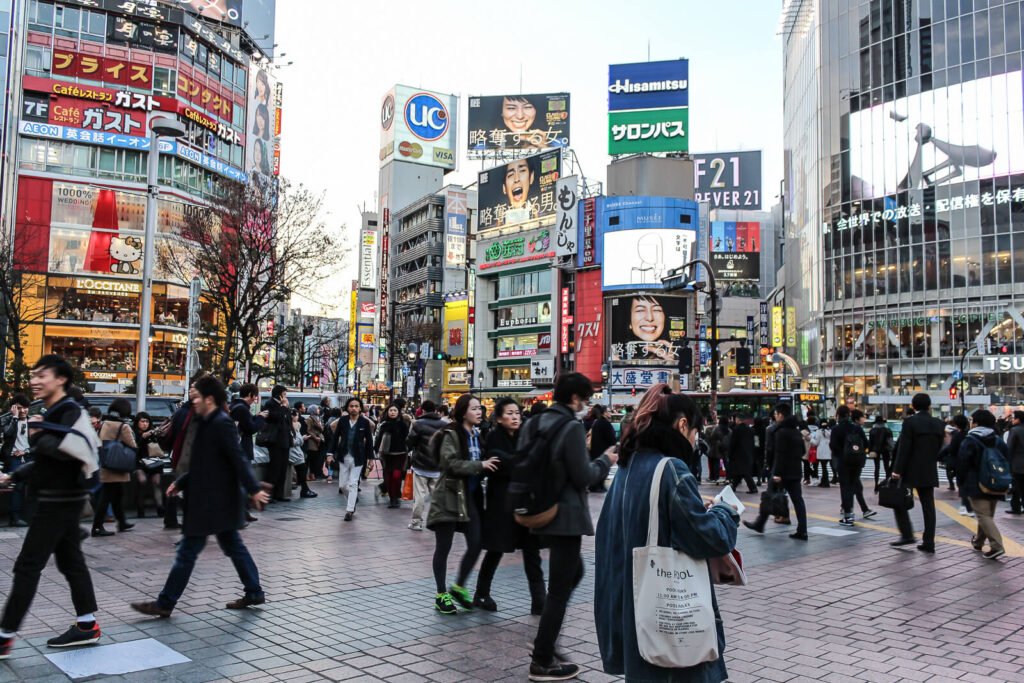


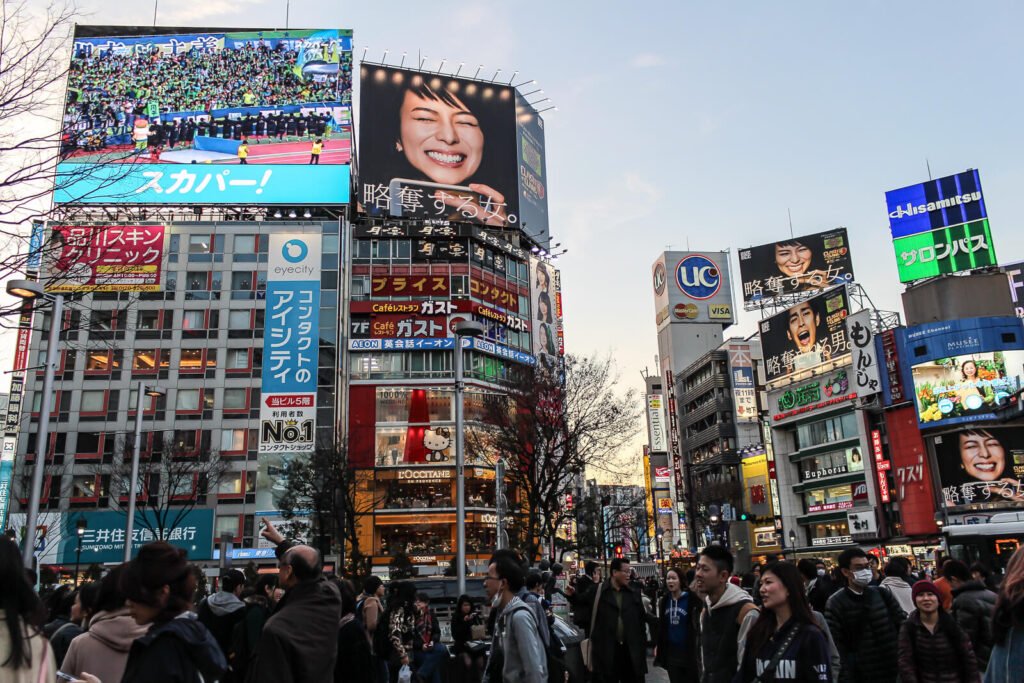


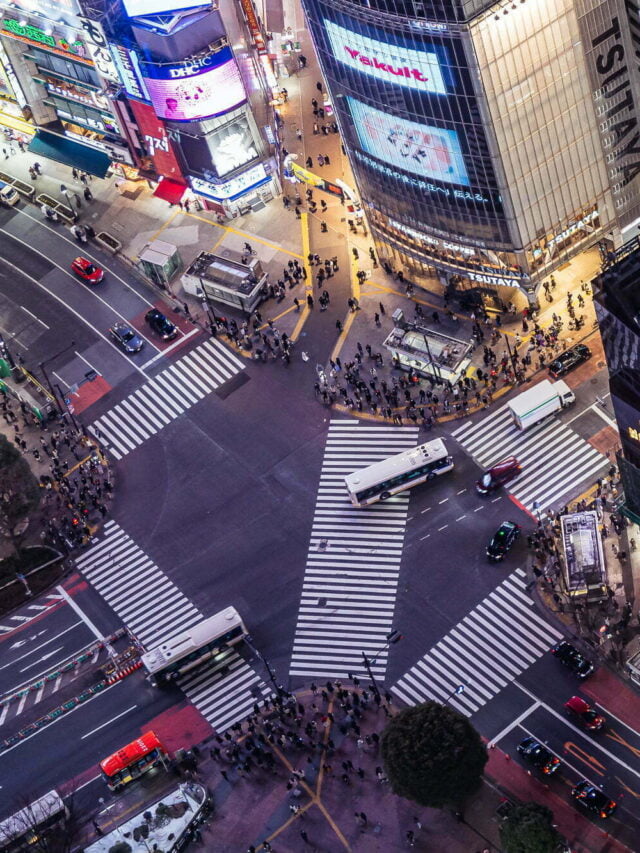
A Glimpse into Shibuya’s Soul
Shibuya Crossing: The Epicenter of Urban Culture
Shibuya is more than just a district—it’s a cultural phenomenon that encapsulates Tokyo’s spirit. With its vibrant nightlife, cutting-edge fashion, and bustling streets, Shibuya represents the city’s energy and innovation.
The Shibuya Scramble: Chaos in Motion

The expansive scramble intersection, located right outside Shibuya Station, serves as a quintessential representation of Tokyo. It pulsates with constant activity in every conceivable direction. Dominating the scene are three colossal television screens affixed to the buildings that overlook the intersection, their vibrant displays illuminating the area throughout the day. This captivating spectacle is complemented by an abundance of lights, an array of captivating advertisements, and an overall aura of luminosity that engulfs the vicinity. In essence, Tokyo Shibuya Crossing is a dynamic microcosm of the city itself, where the energy of urban life converges in a mesmerizing display of sights and sounds.
This article includes affiliate links that do not incur additional charges for you. I may receive a modest commission if you click on them and make a purchase.
Day and Night: The Ever-Pulsating Energy


Whether it’s the rush of commuters on their way to work or the vibrant nightlife of revelers, Shibuya Crossing never sleeps. From dawn till dusk, the crossing pulses with life, embodying Tokyo’s 24/7 rhythm.
The Tokyo Shibuya crossing is not only renowned for its iconic pedestrian scramble but also as a vibrant nightlife hub. This lively area is brimming with a diverse array of bars, clubs, and izakayas, making it a magnet for nocturnal enthusiasts seeking a memorable evening out. On weekends, the streets come alive with the spirit of revelry, creating a dynamic atmosphere that is a common sight for both locals and visitors alike.
Additionally, the Tokyo Shibuya crossing is a fashionable shopping destination. Its trendy shopping district attracts fashion-conscious shoppers looking for the latest trends and unique finds. In essence, this bustling intersection transcends its daytime fame, transforming into a multifaceted hotspot that caters to a wide range of interests, from nightlife seekers to fashion enthusiasts.
You may also like to read: Japanese Temples: Senso-ji and Nakamise Shopping Street
The Evolution of Shibuya Crossing
Origins and Early Transformations
The Tokyo Shibuya crossing has a rich history that spans more than a century, with its origins tracing back to the establishment of Shibuya Station in 1885. This historic transportation hub laid the foundation for what would eventually become the bustling intersection we know today.
The iconic Shibuya Crossing, as it stands today, officially came into existence in 1973. This marked a significant milestone in its evolution, as it transformed into the renowned pedestrian scramble that captures the essence of Tokyo’s vibrant urban life. Over the years, it has grown to symbolize not only a practical intersection but also a cultural landmark, attracting visitors from around the world who are eager to experience its unique energy and history.
Becoming a Global Phenomenon
Shibuya Crossing’s distinctive chaos captured the attention of the world. It’s no longer just a place to cross the road; it’s an experience—an adrenaline rush that encapsulates the modern essence of Tokyo.
Iconic Moments and Media Appearances
Shibuya Crossing has made appearances in countless films, television shows, and documentaries. Its captivating visual spectacle and dynamic energy have made it a favorite backdrop for cinematic storytelling. The Tokyo Shibuya crossing has gained significant recognition as a sought-after filming location within Tokyo. It has played a prominent role in notable films such as “Lost in Translation” and “The Fast and the Furious: Tokyo Drift.” This iconic intersection has become a cinematic symbol of the bustling city, attracting filmmakers and media productions looking to capture the vibrant essence of Tokyo life.
A Symbol of Modernity and Progress
Reflecting Tokyo’s Urban Landscape
Shibuya Crossing is a microcosm of Tokyo’s urban landscape—constantly evolving, always bustling, and forever changing. It’s a reflection of Tokyo’s commitment to progress and innovation.

The Intersection of Culture and Commerce
Surrounding Shibuya Crossing are towering skyscrapers, neon billboards, and bustling shopping centers. This is where culture meets commerce, where traditional temples coexist with cutting-edge fashion boutiques.
Shibuya Crossing in Popular Culture
Shibuya Crossing’s magnetic pull extends beyond its physical boundaries. It’s not just a location; it’s a symbol that resonates with people worldwide, becoming a part of Tokyo’s identity in popular culture.
Visitor Experience: Embracing the Chaos
Observing from Above: Scenic Views


For an unparalleled panoramic view of Tokyo, make your way to the remarkable 360° open-air observation deck atop Shibuya Scramble Square. Soaring to a staggering height of 230 meters, this architectural marvel claims the title of the tallest structure in the Shibuya district. Aptly named “Shibuya Sky,” the observation deck offers visitors an extraordinary vantage point to admire the sprawling beauty of Tokyo from above. Whether it’s the city’s skyline, the bustling streets, or the mesmerizing Shibuya Crossing below, this elevated experience promises to be a highlight of your visit to Tokyo.
Immersing in the Crowd: Ground-Level Thrills
To truly experience the energy, immerse yourself in the crowd. Stand at one of the crossing points and become part of the dynamic flow, where strangers become companions in the shared journey.
Capturing the Essence: Photography Tips
Photographers flock to Shibuya Crossing for its unique visual spectacle. To capture the essence of the crossing, experiment with long exposure shots to capture the movement of the crowd against the backdrop of city lights.
Here are five concise tips for photographing the Tokyo Shibuya crossing:
- Choose the Right Time: Opt for either the golden hour in the evening or early morning to capture the best lighting. Overcast days can also provide excellent conditions, avoiding harsh shadows.
- Weekdays Are Ideal: Visit during weekdays, preferably in spring or autumn when it’s not too hot, for a chance to capture the iconic salarymen and the daily hustle and bustle.
- Experience the Scene: Take time to experience Shibuya Crossing yourself, but be mindful of pedestrians and traffic signals while taking photos.
- Explore Vantage Points: Seek out elevated spots, such as the walkway connecting Shibuya Station to Shibuya Mark City, for unique vantage points.
- Consider Starbucks: For the classic shot, visit the Starbucks overlooking the crossing, but be prepared for potential challenges with reflections and tinted windows. You can use tables for stable long exposures or capture stationary subjects for an interesting contrast.
Bonus: Consider the Hikarie building’s 11th floor for an aerial shot if you have a telephoto lens.
You may also like to read: Tokyo Tower: Panoramic City Views
Shibuya Crossing: More Than Meets the Eye
Surrounding Attractions and Landmarks
- Explore the iconic Hachiko dog statue, a must-visit landmark at Shibuya Station.
- Enjoy Tokyo’s premier shopping destinations, including Shibuya 109, Center Gai, Tokyu, Marui, Scramble Square and many others, offering a diverse range of shopping experiences.



Hidden Gems: Exploring Beyond the Intersection
While the crossing takes center stage, Shibuya has hidden gems waiting to be discovered. Tranquil parks, quaint cafes, and charming side streets offer respite from the bustling energy.
The Human Tapestry of Tokyo’s Diversity
As thousands of people crisscross the Shibuya Crossing, it’s a reminder of Tokyo’s diversity. Here, locals and visitors from around the world merge, creating a human tapestry that celebrates unity amidst the urban chaos.

Access
- Shibuya Crossing is situated right outside the Hachiko exit of Shibuya Station.
- To reach Shibuya Crossing, you can take the JR Yamanote Line, which is a part of the major city loop, and disembark at Shibuya Station.
- Alternatively, several other train lines also stop at Shibuya Station, including the JR Saikyo and Shonan Shinjuku lines, the Keio Inokashira Line, the Tokyu Den-en-toshi Line, and the Tokyu Toyoko Line.
- Additionally, the Tokyo Metro provides access to Shibuya via the Ginza, Hanzomon, and Fukutoshin subway lines.
Conclusion
The Shibuya Crossing is more than a place—it’s an experience that captures the spirit of Tokyo. As pedestrians converge and diverge in a mesmerizing dance, the crossing becomes a living testament to Tokyo’s dynamism, progress, and harmonious blend of tradition and modernity. In the heart of this bustling intersection, Tokyo’s soul comes alive—a vibrant pulse that continues to captivate all who venture into its chaos.


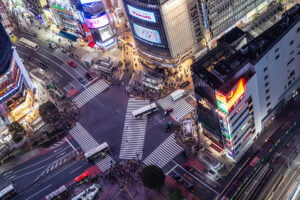

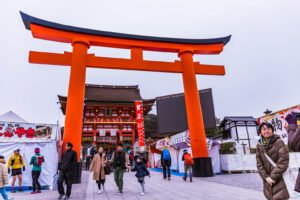
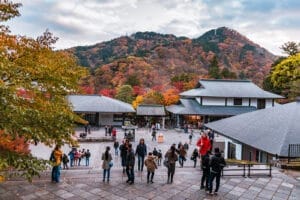
Pingback: 20 Best Budget Hotels Tokyo: Affordable Stays in the Heart of Japan’s Capital - airashijapan.com
Pingback: Kichijoji: Unveiling the Charm of Tokyo’s Hidden Gem - airashijapan.com
Pingback: The Mystical Allure of the Torii Gate: A Gateway to Japanese Culture - airashijapan.com
Pingback: Yanaka: Old-World Charm and Quaint Streets - airashijapan.com
Pingback: Exploring Tokyo: Unveiling Top Attractions and Hidden Gems - airashijapan.com
Pingback: Japanese Temples: Senso-ji and Nakamise Shopping Street - airashijapan.com
Pingback: Exploring the Heart of Tokyo: Shinjuku - airashijapan.com
Pingback: Omoide Yokocho: Tokyo’s Nostalgic Alley of Memories - airashijapan.com
Pingback: Akihabara Electric Town : Tech and Anime Haven - airashijapan.com
Pingback: Roppongi Tokyo: Fusion Hub of Culture and Nightlife - airashijapan.com
Pingback: Harajuku Japan: A Trendsetter’s Haven - airashijapan.com
Pingback: Navigating Tokyo Transportation efficiently - airashijapan.com
Pingback: Best Places to See Autumn Foliage in Tokyo - airashijapan.com
Pingback: Exploring Kagurazaka: A Tapestry of Tradition and Modernity in Tokyo - airashijapan.com
Pingback: Best Japan Travel Apps - airashijapan.com
Pingback: Recommended Reading for Your Journey to Japan - airashijapan.com
Pingback: Spring in Tokyo: Sakura Dreams at Shinjuku Gyoen - airashijapan.com
Pingback: Harajuku St: Where Tokyo Street Photography Comes Alive - airashijapan.com